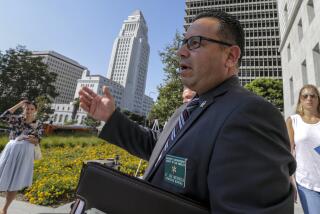THE SAN MARINO TRAGEDY : A Deadly Attraction to the Gang Lifestyle : Increasingly, ordinary students are mimicking gangbangers’ dress and swagger. It’s a trend that experts say may have contributed to the shooting deaths of two youths last week.
- Share via
When a high school graduation party ended with two teen-agers shot to death by gang members, it mattered little that the suspects were classified as “outsiders” by San Marino police. It still seemed inconceivable to parents that their children, living in one of the nation’s safest and most affluent cities, could have collided so fatally with gangs.
But some law enforcement officials, local teen-agers and a counselor who specializes in the problems of Asian youths were less surprised.
Not that San Marino is any hotbed of gang activity, they say. But the thrill and power associated with gangs has for years been a casual flirtation for some San Marino youths, who affect the dress and swagger of gangsters and sometimes befriend gangbangers, blurring the lines of distinction. On June 5, that attraction turned deadly.
“If you walk and talk and quack like a duck, look out for duck hunters,” said Glenn Masuda, a psychologist with the Asian Pacific Family Center who works with adolescents.
He and other counselors of adolescents in the valley say many affluent youths from good families find it hard to resist the sinister allure of gang culture.
These young people ape gang styles, dressing in the baggy clothing popular among bands shown on MTV. Some wear buzz haircuts and sport gold stud earrings. They give themselves gang monikers and hang out together, often at San Gabriel Valley pool halls or parties where gang members congregate. While they may not commit crimes, they get vicarious thrills from rubbing elbows with those who do.
“That can get real dangerous because it blurs the distinction of who’s a heavy hitter, who’s involved and who’s just in style,” Masuda said. The flirtation with the dark side can quickly lead to trouble, said Masuda, who has counseled youths who were attacked by real gang members who mistook them for members of a rival gang.
“We’ve had a number of good kids at the counseling center who come in, dressed to the nines, saying, ‘Why did they beat us up or shoot at us?’ ” Masuda said.
There were subtle hints of gang influence hovering over the San Marino party where Dennis Buan and David Hang were gunned down. The flyer advertising the party was written partially in gang script, Masuda said.
“Entertainment provided by LORDS,” the flyer read, with the word LORDS in elaborate, graffiti-like lettering.
Likewise, the presence of metal detectors brought to the party by disc jockeys to screen patrons may have been only a novelty, as the San Marino police suggested, but it simulated a giddy danger, youth counselors said.
Although San Marino students and parents say that slaying victim Hang, a 14-year-old San Marino High School freshman, was not a gang member, a source close to the murder investigation said that Hang had been a gang wanna-be since the age of 10. When he died, he was wearing a belt with the letter S , indicating a gang subgroup of the Chinese gang Wah Ching.
Students who played on Hang’s Chinese basketball league team said that when the boy entered San Marino High he sought acceptance among those wearing gang attire and began dressing the same way.
Dennis Buan, an 18-year-old South Pasadena High School senior who was hired to help the party’s disc jockey, was not a gang member, authorities said. But one official said Dennis’ older brother, Luigi, who also helped the disc jockey at the party, belonged to a long-established Latino gang based in Downtown Los Angeles.
Luigi Buan could not be reached for comment, but San Marino police have blamed the gang activity at the party on the disc jockey connection.
“Nobody said that socioeconomic barriers determine gang affiliation,” said one law enforcement official familiar with the investigation. “There’s a lot of gang influence in the high school. . . . They do it for thrills.”
A teacher in the South Pasadena-San Marino area who did not want his name used said he and other educators are perpetually puzzled about the extent of gangs at their schools.
“Kids take a pride in you not knowing for sure if they’re in a gang,” the teacher said. “They’ll give you a look, an attitude. They walk around together and you don’t know whether or not you can mess with them.”
Some students at San Marino High, who declined to give their names for fear of retaliation, said the gang presence is real and growing. Two factions exist, they said.
One group wears popular gang attire, such as baggy shirts and pants. Members of the other group dress sharply in suits and claim affiliation with Wah Ching.
“There’s a lot of people who claim (Wah Ching), but maybe four or five people actually are” on campus, said one San Marino youth who claimed to be a gang member.
“The gangs are growing,” he said. “Nothing is being done about it. If (school administrators) restricted clothing . . . there would be too many people who would protest.”
The students acknowledged that most “open” parties also attract gangs from nearby cities. One San Marino student said that gang members from other schools showed up at three parties he has attended. But there were no confrontations.
However, trouble did erupt on the San Marino campus recently after a group of students who wear the baggy, gang-style clothing--but who are not necessarily gang members--were accused of vandalism, students said. Three freshmen from that group were arrested by police last month on suspicion of stealing Honda, Acura and other car emblems from vehicles parked on campus lots and public streets, a 17-year-old junior said.
The girl said it has become a fad in school for students to use the emblems for key chains or decorations on backpacks.
“I don’t know of any gangs we have on campus,” she said. “I think it all comes with the wanna-be hard look, with the ‘respect’ you want to get from other people. . . . If anything, it’s a bunch of bragging. ‘I know so-and-so (from Wah Ching).’ ”
At a public meeting earlier this month, San Marino High School Principal Don Banderas acknowledged that 40 cars in the school parking lot had been vandalized, but he said the three students were required to pay restitution and he downplayed any gang connection.
The law enforcement official, who requested anonymity, said that San Marino is home to at least six high-level Asian gang members in their mid-40s. These men have ties to sophisticated international Hong Kong-based groups such as the Wah Ching and 14K.
But these upper-echelon men are not active in San Marino, the official said. Instead, the gang influence among youths comes from dai-los, a Mandarin term meaning big brothers. It refers to lower-ranked members within the highly structured Asian gang hierarchy.
Evidence has turned up that at least one dai-lo in his 30s has recently been recruiting students from San Marino and South Pasadena, the official said. The recruitment is not done directly but via lieutenants who meet teen-agers through other students they know on campus and treat the young people to dinners, movies or parties, the official said.
“He’s real mobile,” the official said. “He’s got people from Rowland Heights, San Dimas and Diamond Bar. He uses cars, phones and pagers. And what do these (San Marino) kids have? Cars, phones and pagers.”
Torres is a Times staff writer; Li is a Times correspondent. Times staff writer Denise Hamilton contributed to this story.
More to Read
Sign up for Essential California
The most important California stories and recommendations in your inbox every morning.
You may occasionally receive promotional content from the Los Angeles Times.










